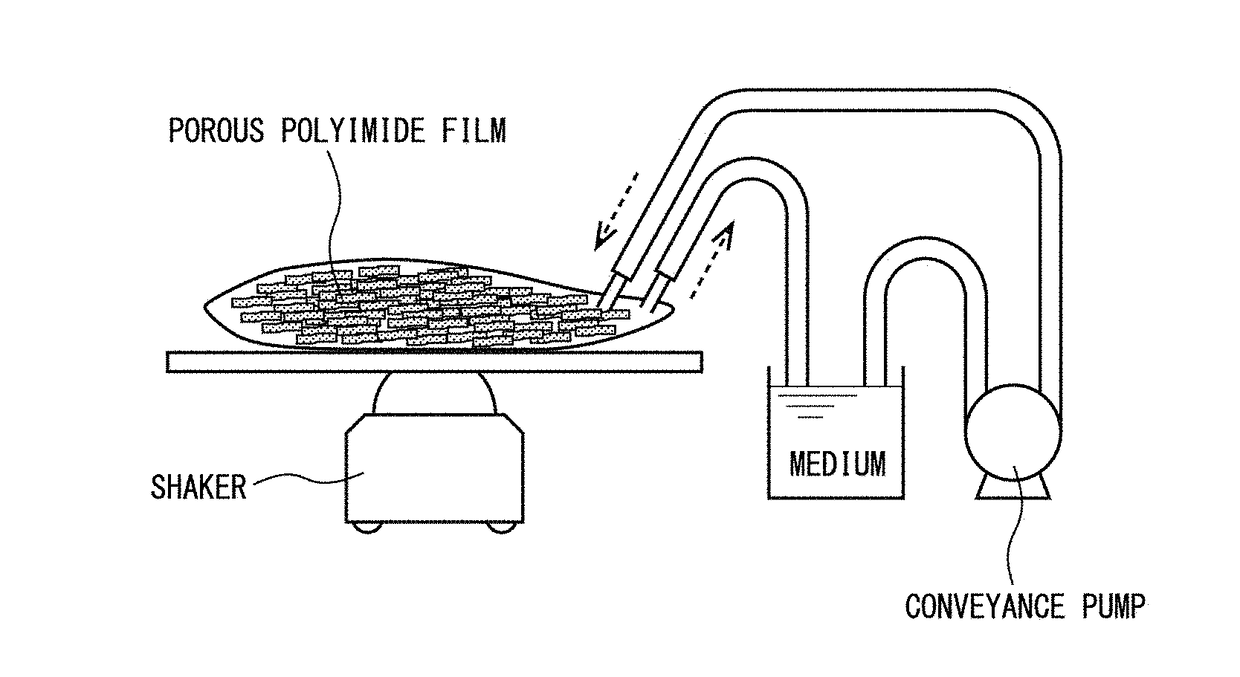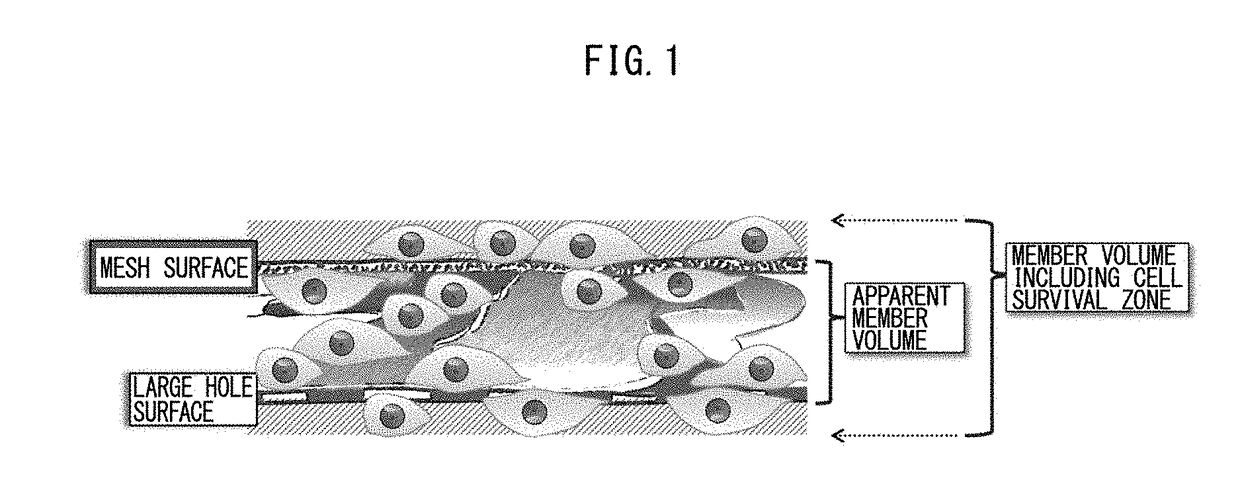Method, device and kit for mass cultivation of cells using polyimide porous membrane
- Summary
- Abstract
- Description
- Claims
- Application Information
AI Technical Summary
Benefits of technology
Problems solved by technology
Method used
Image
Examples
example 1
Mass Culturing of Human Skin Fibroblasts Using Porous Polyimide Film
[0273]Human skin fibroblasts were used for seeding in a porous polyimide film, and then mass culturing was carried out in a dish.
[0274]After adding 0.5 ml of 2% FBS-containing cell culture medium to a 2 cm×2 cm sterilized square vessel, a sterilized 1.4 cm-square porous polyimide film was immersed therein with the A-surface of the mesh structure or the B-surface of the large-gap structure facing upward. Separately, there was prepared a human skin fibroblast suspension with human skin fibroblasts suspended at 2.1×106 cells per 1 ml of medium (of which 1.9×106 were viable cells and 1.6×105 were dead cells, for a viable cell rate of 92%). The cell suspension was added at 50 μl to the cell culture medium in the square vessel.
[0275]After culturing for 24 hours in the square vessel, 150 cell-seeded sheets were transferred to three 20 cm2 dishes, 50 sheets at a time, 4 ml of medium was added, and culturing was continued. A...
example 2
Mass Culturing of CHO-K1 Cells Using Porous Polyimide Film
[0276]For this example, CHO-K1 cells were used for seeding in a porous polyimide film, and then mass culturing was carried out in a dish.
[0277]After adding 0.5 ml of 2% FBS-containing cell culture medium to a 2 cm×2 cm sterilized square vessel, a sterilized 1.4 cm-square porous polyimide film was immersed therein with the A-surface of the mesh structure facing upward. Separately, a CHO-K1 cell suspension was prepared with the CHO-K1 cells suspended at 5.0×106 cells per 4 ml of medium (of which 4.5×106 were viable cells and 4.7×105 were dead cells, for a viable cell rate of 91%). The cell suspension was added at 40 μl to the cell culture medium in the square vessel.
[0278]After culturing for 24 hours in the square vessel, 25 cell-seeded sheets were transferred to one 20 cm2 dish and collected, 2 ml of medium was added, and culturing was continued. After 11 days, 18 days and 20 days, CCK8 was used to measure the cell count and o...
example 3
Mass Continuous Culturing of CHO-K1 Cells Using Porous Polyimide Films
[0279]For this example, CHO-K1 cells were used for seeding in porous polyimide films, and then mass continuous culturing was carried out using a continuous culturing apparatus.
[0280]Ten 4 cm×10 cm sterilized porous polyimide films were subjected to dry heat sterilization, and arranged in a sterilized rectilinear dish. A suspension was prepared including 1.1×107 CHO-K1 cells per 5 ml of medium (of which 1.1×107 were viable cells and 5.0×105 were dead cells, for a viable cell rate of 96%), and 0.5 ml was seeded into each of the previously prepared porous polyimide films. Each suspension placed on the sheets was homogenized with a cell scraper, and the solution was caused to pass through by slightly moving the sheets, thereby seeding the cells into the porous polyimide films. The 10 sheets were layered with their A-surfaces facing upward and placed on a stainless steel metal mesh of the same size, while PE / PP-mixed n...
PUM
| Property | Measurement | Unit |
|---|---|---|
| Temperature | aaaaa | aaaaa |
| Fraction | aaaaa | aaaaa |
| Angle | aaaaa | aaaaa |
Abstract
Description
Claims
Application Information
 Login to View More
Login to View More - R&D
- Intellectual Property
- Life Sciences
- Materials
- Tech Scout
- Unparalleled Data Quality
- Higher Quality Content
- 60% Fewer Hallucinations
Browse by: Latest US Patents, China's latest patents, Technical Efficacy Thesaurus, Application Domain, Technology Topic, Popular Technical Reports.
© 2025 PatSnap. All rights reserved.Legal|Privacy policy|Modern Slavery Act Transparency Statement|Sitemap|About US| Contact US: help@patsnap.com



